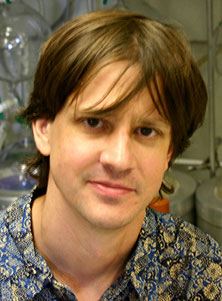Psst, you’re a genius -- don’t tell anybody yet: Harbury named MacArthur Fellow
Pehr Harbury arrived at his sister’s house in Boston on Sept. 15 an ordinary man and left a genius. And his family didn’t notice a thing. Although Harbury learned that afternoon when returning a phone message that he had been named a MacArthur Fellow—a national honor frequently called the “genius grant”— he had to keep his excitement to himself.
“It was completely unexpected,” said Harbury of the recognition, which includes a $500,000 grant that recipients can use to advance their life’s work in any way they see fit. “It was fantastic to hear that I was a MacArthur Fellow. But then they asked me not to tell anyone for a few days.”
Such reticence was likely difficult for the tall, energetic Menlo Park native with an engaging smile and rapid conversation. The 40-year-old Harbury, who is an associate professor in biochemistry at Stanford’s School of Medicine, is equally at home in the lab, or at his newly purchased “wreck” of a home in the Santa Cruz mountains, where he battles for possession with local rattlesnakes. So far the snakes are losing.
Although Harbury may have been surprised by the phone conversation last week, others in his department were not.
“Pehr has a remarkable intellect and a broad knowledge of biomedical science,” said Suzanne Pfeffer, PhD, professor and chair of biochemistry who helped recruit Harbury to Stanford in 1997. “In a job search of more than 350 candidates, he was clearly head and shoulders above the rest. He could talk about anyone else’s research at a very sophisticated level, and he was doing very creative work.”
Indeed, creativity is one of the three main requirements, along with originality and potential, used by the John D. and Catherine T. MacArthur Foundation to select the award recipients. Harbury shares the honor with 24 other new fellows this year, including a sculptor, a violin maker, a conservation biologist and a rare book preservationist. The names of the fellows were announced Sept. 20.
Harbury’s most well-known research focuses on devising ways to use DNA molecules as blueprints for the synthesis of small chemical compounds that may be useful in drug design. The new compounds carry with them their unique DNA tags. Researchers test a large pool of candidates for a desired trait—such as strong binding to an enzyme or protein important in a disease process—and sort the most promising according to their attached DNA sequences. Repeated cycles of synthesis, using the “assembly instructions” contained in the tag, and testing allow them to home in on novel molecules that deserve further research.
“We’re trying to put the 'magic' into the magic bullet of drug design,” said Harbury, who likens the process to how selective breeding is used to enrich preferred traits in an animal population.
Harbury hasn’t decided exactly how to spend his new windfall. He knows he’ll use a portion of it to supplement the salaries of the post-docs and graduate students in his lab, which are only partially covered by NIH grants, up to Stanford-required levels. After that, well, “we’ll probably set some aside for the more wacky ideas that we have in the pipeline,” he said.
The MacArthur Award isn’t the first national recognition Harbury has received. He has been working his way into the ranks of biochemistry’s elite during the past few years with a series of awards—the 2004 Schering-Plough Young Investigator Award, the Searle Scholar Young Investigator Award, and a Burroughs-Wellcome Young Investigator Award. He was also named one of 100 Young Innovators by MIT’s Technology Review magazine in 1999. But none of these came with such tangible, and necessary, rewards as the MacArthur Fellowship.
“Funding in the lab has been very tough lately,” said Harbury, noting that he has spent much of the past 18 months writing grant applications. “This is a huge relief.”
Harbury’s local lineage goes all the way back to 1970s when he attended Oak Knoll Elementary and Hillview Middle School in Menlo Park. He came to Stanford in the fall of 1997 after completing postdoctoral work at the University of California-Berkeley. He received his BA in biochemistry and his PhD in biological chemistry from Harvard. His PhD work was conducted at MIT’s Whitehead Institute.
“I feel extremely lucky to be at Stanford,” he said. “I came here because it has a reputation for technical development, and for allowing people to go out on a limb and try hard things. Historically it’s also one of the greatest biochemistry departments in the world, and it has a wonderfully warm community of researchers.”
His community is celebrating with him now. Three bottles of Scotch and a bottle of champagne lined his desk on a recent day, and the members of his lab are all smiles. There’s talk of a yet-to-be planned party at his house—or, given the snake situation there, maybe the apartment he’s currently occupying would be safer? And they’re already sharing stories about him.
“I remember during the recruiting process,” said Pfeffer, “reading a letter of recommendation written by Pehr’s former PhD mentor. He wrote 'This man is a genius,' and I just rolled my eyes thinking, 'Come on! What an exaggeration.' Then we met Pehr, and realized it was true. We joke about it now, but it’s fully appropriate that he has received this award. He deserves it.”


Share This Story